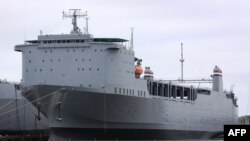WASHINGTON —
The Organization for the Prohibition of Chemical Weapons, or OPCW, which has been tasked with ensuring that Syria destroys its chemical weapons arsenal by the middle of next year, outlined its plans for accomplishing that task this week. It will not be easy, and OPCW Director General Ahmet Uzumcu said that states assisting in the mission have, “in the interest of the common good, assumed onerous responsibilities” in executing a plan that has been so quickly put together.
Gregory Koblentz, Deputy Director of the Biodefense Program at Virginia’s George Mason University, says the initial phase of the plan involves transporting the chemicals overland across Syria.
“The chemicals are going to be packaged in Syria and then shipped overland to the city of Latakia, which is a major port on the Mediterranean,” Koblentz said.
“And then the chemicals will be picked up by Norwegian and Danish ships, which will then transport them to Italy.”
There, the chemicals will be loaded on an American ship which has been outfitted with equipment to neutralize the chemicals.
Koblenz says that while the first stage of the plan is risky because it involves transporting chemicals across a country at war, he is optimistic the chemicals will make it to Latakia securely.
“Up until now, there’ve not been any significant reports that the conflict has interfered with the consolidation of the chemicals and the OPCW’s actions on the ground,” Koblentz said. “So while the route from Damascus to Latakia might be somewhat troublesome, the rebels so far have cooperated with the OPCW, and it’s in their interest to have these chemicals to get out of the country.”
Multinational effort
Uzumcu told his executive council Tuesday that Syria will bear sole responsibility for the packing and transport of the materials. The US has supplied nearly 3,000 container drums, among other equipment, as well as GPS locators that will allow authorities to know where the cargo is at all times.
Russia is providing large capacity and armored trucks, water tanks, and other logistical supplies. Moscow has also said it will provide security for operation at the port and in Syrian territorial waters. It is unclear from reports whether Russia will also provide transportation or security during the land phase of the operation.
China is providing surveillance cameras and 10 ambulances.
Risky business
The original goal was to remove the most critical chemicals from Syria by the end of the year, but the OPCW has warned there may be delays.
“We must also remember that the mission in the Syrian Arab Republic is making progress against heavy odds,” Uzumcu warned. “The continued heavy fighting in the Qalamoun and surrounding areas and the closure of a major arterial road between Damascus and Homs pose risks to the timely execution of the operation.”
But time is not the only worry, says chemical weapons expert Amy Smithson, Senior Fellow at the James Martin Center for Nonproliferation Studies.
“That’s a lot of stuff going down the road—in distinctive trappings,” she said, describing a ‘caravan’ of trucks carrying large container drums, surrounded by security.
“There are all sorts of warring parties in Syria—some 200 entities including Al Qaeda and Hezbollah who might view this as an attractive target.”
If there is a time that will keep proliferation experts up at night says Smithson, this would be it.
“Once the cargo makes it to Latakia,” Smithson said, “we are in very familiar territory.”
Danish and Norwegian ships will transport the chemicals to an Italian port which has not been specified. “My guess would be Naples,” Smithson said, “because the U.S. Navy has had a presence there for decades.”
There, about 500 metric tons of the most dangerous chemical material will be loaded onto an American ship, the MV Cape May, which has been outfitted with two field hydrolysis systems which will degrade the mustard gas and the most hazardous chemicals. The ship will also transport and dispose of the waste material generated by the process.
Meanwhile, a number of private commercial companies will transport about 800 metric tons of industrial-grade organic and non-organic chemicals to private facilities, where they will be disposed of.
Smithson says that these companies will operate according to laws and regulations for the safe and environmentally responsible handling of toxic chemical waste in their respective countries.
Since they are apparently all U.S. and European firms, she says those regulations are among the toughest—“if not the toughest” in the world.
Gregory Koblentz, Deputy Director of the Biodefense Program at Virginia’s George Mason University, says the initial phase of the plan involves transporting the chemicals overland across Syria.
“The chemicals are going to be packaged in Syria and then shipped overland to the city of Latakia, which is a major port on the Mediterranean,” Koblentz said.
“And then the chemicals will be picked up by Norwegian and Danish ships, which will then transport them to Italy.”
There, the chemicals will be loaded on an American ship which has been outfitted with equipment to neutralize the chemicals.
Koblenz says that while the first stage of the plan is risky because it involves transporting chemicals across a country at war, he is optimistic the chemicals will make it to Latakia securely.
“Up until now, there’ve not been any significant reports that the conflict has interfered with the consolidation of the chemicals and the OPCW’s actions on the ground,” Koblentz said. “So while the route from Damascus to Latakia might be somewhat troublesome, the rebels so far have cooperated with the OPCW, and it’s in their interest to have these chemicals to get out of the country.”
Multinational effort
Uzumcu told his executive council Tuesday that Syria will bear sole responsibility for the packing and transport of the materials. The US has supplied nearly 3,000 container drums, among other equipment, as well as GPS locators that will allow authorities to know where the cargo is at all times.
Russia is providing large capacity and armored trucks, water tanks, and other logistical supplies. Moscow has also said it will provide security for operation at the port and in Syrian territorial waters. It is unclear from reports whether Russia will also provide transportation or security during the land phase of the operation.
China is providing surveillance cameras and 10 ambulances.
Risky business
The original goal was to remove the most critical chemicals from Syria by the end of the year, but the OPCW has warned there may be delays.
“We must also remember that the mission in the Syrian Arab Republic is making progress against heavy odds,” Uzumcu warned. “The continued heavy fighting in the Qalamoun and surrounding areas and the closure of a major arterial road between Damascus and Homs pose risks to the timely execution of the operation.”
But time is not the only worry, says chemical weapons expert Amy Smithson, Senior Fellow at the James Martin Center for Nonproliferation Studies.
“That’s a lot of stuff going down the road—in distinctive trappings,” she said, describing a ‘caravan’ of trucks carrying large container drums, surrounded by security.
“There are all sorts of warring parties in Syria—some 200 entities including Al Qaeda and Hezbollah who might view this as an attractive target.”
If there is a time that will keep proliferation experts up at night says Smithson, this would be it.
“Once the cargo makes it to Latakia,” Smithson said, “we are in very familiar territory.”
Danish and Norwegian ships will transport the chemicals to an Italian port which has not been specified. “My guess would be Naples,” Smithson said, “because the U.S. Navy has had a presence there for decades.”
There, about 500 metric tons of the most dangerous chemical material will be loaded onto an American ship, the MV Cape May, which has been outfitted with two field hydrolysis systems which will degrade the mustard gas and the most hazardous chemicals. The ship will also transport and dispose of the waste material generated by the process.
Meanwhile, a number of private commercial companies will transport about 800 metric tons of industrial-grade organic and non-organic chemicals to private facilities, where they will be disposed of.
Smithson says that these companies will operate according to laws and regulations for the safe and environmentally responsible handling of toxic chemical waste in their respective countries.
Since they are apparently all U.S. and European firms, she says those regulations are among the toughest—“if not the toughest” in the world.










